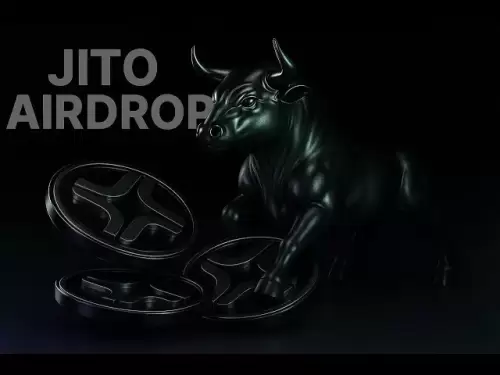-
 Bitcoin
Bitcoin $118600
0.36% -
 Ethereum
Ethereum $3855
1.06% -
 XRP
XRP $3.195
-0.09% -
 Tether USDt
Tether USDt $1.000
-0.04% -
 BNB
BNB $844.5
6.23% -
 Solana
Solana $191.3
2.83% -
 USDC
USDC $0.9997
-0.01% -
 Dogecoin
Dogecoin $0.2376
0.10% -
 TRON
TRON $0.3242
0.83% -
 Cardano
Cardano $0.8222
0.13% -
 Hyperliquid
Hyperliquid $45.26
6.53% -
 Sui
Sui $4.200
-2.56% -
 Stellar
Stellar $0.4336
-1.24% -
 Chainlink
Chainlink $18.86
0.28% -
 Hedera
Hedera $0.2796
-1.75% -
 Bitcoin Cash
Bitcoin Cash $583.3
-1.84% -
 Avalanche
Avalanche $27.06
8.09% -
 Litecoin
Litecoin $112.3
-1.16% -
 Toncoin
Toncoin $3.353
0.58% -
 UNUS SED LEO
UNUS SED LEO $8.968
-0.11% -
 Shiba Inu
Shiba Inu $0.00001395
-0.54% -
 Ethena USDe
Ethena USDe $1.001
-0.03% -
 Uniswap
Uniswap $10.76
0.69% -
 Polkadot
Polkadot $4.175
0.26% -
 Monero
Monero $326.7
1.07% -
 Bitget Token
Bitget Token $4.665
1.61% -
 Dai
Dai $0.9998
-0.02% -
 Pepe
Pepe $0.00001271
0.32% -
 Cronos
Cronos $0.1416
2.01% -
 Aave
Aave $299.3
1.15%
Does the Hull Moving Average HMA react faster? What is its advantage over the traditional moving average?
The Hull Moving Average (HMA) reduces lag and increases responsiveness, making it a valuable tool for traders to identify trends quickly in fast-moving markets.
Jun 10, 2025 at 05:21 am
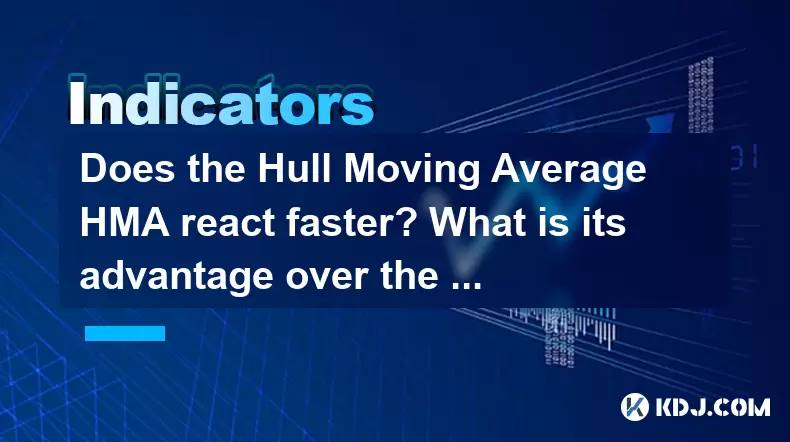
The Hull Moving Average (HMA) is a type of moving average designed to reduce lag and increase responsiveness compared to traditional moving averages. Traders often use moving averages to smooth out price data and identify trends, but traditional moving averages can sometimes lag behind the actual price movements. This article will delve into how the HMA reacts faster than traditional moving averages and explore its advantages.
Understanding the Hull Moving Average
The Hull Moving Average (HMA) was developed by Alan Hull and aims to overcome the lag that is inherent in traditional moving averages. The HMA uses a weighted average method to calculate its values, which helps it to respond more quickly to price changes. The formula for the HMA is more complex than that of simple or exponential moving averages, which contributes to its ability to provide a smoother and more responsive line.
How the HMA Reacts Faster
The HMA's faster reaction time stems from its unique calculation method. Unlike a simple moving average (SMA) that uses an arithmetic mean of a set number of periods, or an exponential moving average (EMA) that gives more weight to recent prices, the HMA uses a combination of weighted moving averages (WMAs) to reduce lag. The formula for the HMA is as follows:
[ \text{HMA} = \text{WMA}(2 \times \text{WMA}(\text{Price}, \frac{n}{2}) - \text{WMA}(\text{Price}, n), \sqrt{n}) ]
This formula involves three steps:
- Calculating the WMA of the price over half the period (n/2).
- Calculating the WMA of the price over the full period (n).
- Subtracting the second WMA from twice the first WMA and then calculating the WMA of the result over the square root of the period (√n).
This method results in a moving average that is more responsive to recent price changes while still smoothing out short-term fluctuations.
Advantages of the HMA Over Traditional Moving Averages
The advantages of the HMA over traditional moving averages are numerous. Firstly, the HMA reduces lag significantly, which allows traders to identify trend changes more quickly. This can be particularly beneficial in fast-moving markets where timely decisions are crucial. Secondly, the HMA provides a smoother line compared to other moving averages, which can help traders to better visualize the underlying trend without the noise of short-term price movements.
Another advantage is that the HMA can be used in various trading strategies, including trend following and mean reversion. Its ability to adapt quickly to price changes makes it a versatile tool for different types of traders. Additionally, the HMA can be used in conjunction with other technical indicators to create more robust trading signals.
Practical Application of the HMA in Trading
To use the HMA in trading, traders can follow these steps:
- Choose a trading platform: Select a trading platform that supports the HMA indicator. Many popular platforms, such as MetaTrader 4 and TradingView, offer the HMA as a built-in indicator.
- Apply the HMA to a chart: Open a price chart for the cryptocurrency you are interested in trading. Locate the HMA indicator in the platform's indicator menu and apply it to the chart. You will need to specify the period (n) for the HMA, which can be adjusted based on your trading strategy.
- Analyze the HMA: Observe the HMA line on the chart. Look for crossovers between the HMA and the price, or between multiple HMAs with different periods, to identify potential entry and exit points. For example, a bullish signal might occur when the price crosses above the HMA, while a bearish signal might occur when the price crosses below the HMA.
- Combine with other indicators: To increase the reliability of your trading signals, consider using the HMA in conjunction with other technical indicators, such as the Relative Strength Index (RSI) or the Moving Average Convergence Divergence (MACD).
Examples of HMA in Cryptocurrency Trading
To illustrate the use of the HMA in cryptocurrency trading, let's consider a few examples. Suppose you are trading Bitcoin (BTC) and want to use the HMA to identify trends. You apply a 21-period HMA to a daily chart of BTC/USD. You notice that the price has been trending above the HMA for several weeks, indicating a strong bullish trend. Based on this signal, you decide to enter a long position.
In another scenario, you are trading Ethereum (ETH) and using a 9-period HMA on a 4-hour chart. You observe that the price has crossed below the HMA, suggesting a potential bearish trend. You decide to enter a short position based on this signal. By monitoring the HMA, you can adjust your position as the trend develops.
Customizing the HMA for Different Trading Styles
The HMA can be customized to suit different trading styles and timeframes. For short-term traders, a shorter period HMA, such as 9 or 14, might be more appropriate, as it will react more quickly to price changes. For long-term traders, a longer period HMA, such as 50 or 200, might be more suitable, as it will provide a smoother line that reflects longer-term trends.
Additionally, traders can experiment with different combinations of HMAs to create more advanced trading strategies. For example, using a fast HMA (such as a 9-period HMA) and a slow HMA (such as a 21-period HMA) can help to identify trend changes more effectively. When the fast HMA crosses above the slow HMA, it can signal a potential bullish trend, while a crossover below can signal a bearish trend.
Potential Limitations of the HMA
While the HMA has many advantages, it is important to be aware of its potential limitations. Like all technical indicators, the HMA is not foolproof and can generate false signals, especially in choppy or sideways markets. Traders should use the HMA in conjunction with other indicators and analysis techniques to increase the reliability of their trading decisions.
Another limitation is that the HMA can be more computationally intensive than traditional moving averages, which may impact performance on some trading platforms. However, this is generally not a significant issue for most traders using modern trading software.
Frequently Asked Questions
Q: Can the HMA be used effectively in all market conditions?
A: The HMA is particularly effective in trending markets, where its ability to quickly adapt to price changes can help traders identify trend changes more accurately. However, in choppy or sideways markets, the HMA may generate more false signals, so it is important to use it in conjunction with other indicators and analysis techniques.
Q: How does the HMA compare to other advanced moving averages like the TEMA (Triple Exponential Moving Average)?
A: Both the HMA and the TEMA are designed to reduce lag and provide a smoother line than traditional moving averages. The HMA uses a weighted average method, while the TEMA uses a triple smoothing technique. The HMA is generally considered to be more responsive to price changes than the TEMA, but both can be effective in different trading strategies.
Q: Is the HMA suitable for all types of cryptocurrency traders?
A: The HMA can be used by a wide range of cryptocurrency traders, from short-term scalpers to long-term investors. However, its effectiveness will depend on the trader's specific strategy and timeframe. Short-term traders may prefer a shorter period HMA, while long-term investors may benefit from a longer period HMA.
Q: Can the HMA be used for automated trading systems?
A: Yes, the HMA can be incorporated into automated trading systems. Many trading platforms and programming languages, such as MQL4 for MetaTrader, support the HMA indicator, allowing traders to develop and backtest automated trading strategies based on the HMA.
Disclaimer:info@kdj.com
The information provided is not trading advice. kdj.com does not assume any responsibility for any investments made based on the information provided in this article. Cryptocurrencies are highly volatile and it is highly recommended that you invest with caution after thorough research!
If you believe that the content used on this website infringes your copyright, please contact us immediately (info@kdj.com) and we will delete it promptly.
- Crypto Investments, Dogecoin Substitutes, and Wealthy Returns: Navigating the Meme Coin Mania and Beyond
- 2025-07-29 00:30:13
- Week Review: July 21 - July 27 - Crypto, AI, and Trade Deals, Oh My!
- 2025-07-29 00:30:13
- Bitcoin, Gold, and Debt Hedges: A New Yorker's Take
- 2025-07-29 00:50:12
- Bitcoin, Japan, Metaplanet: A New Era of Corporate Crypto Adoption?
- 2025-07-29 00:50:12
- Bitcoin Bonanza in Japan: Metaplanet Leads the Charge
- 2025-07-29 00:55:23
- Bitcoin, Merger, and ProCap Financial: A New Era for Crypto in Traditional Finance
- 2025-07-29 00:55:23
Related knowledge
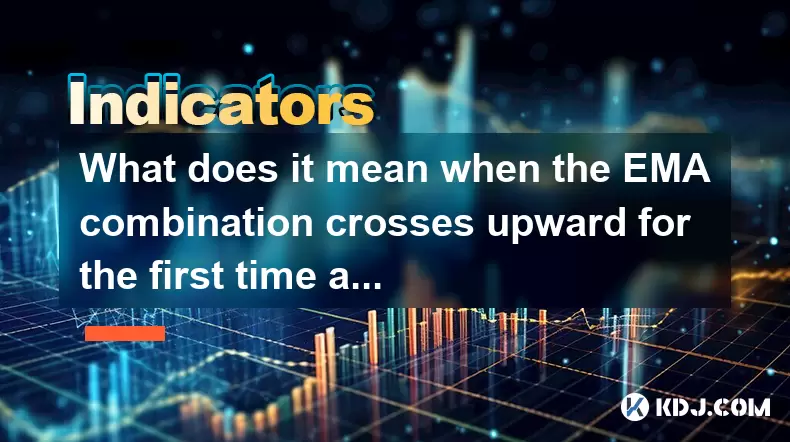
What does it mean when the EMA combination crosses upward for the first time after sideways trading?
Jul 28,2025 at 03:43pm
Understanding the EMA and Its Role in Technical AnalysisThe Exponential Moving Average (EMA) is a widely used technical indicator in cryptocurrency tr...
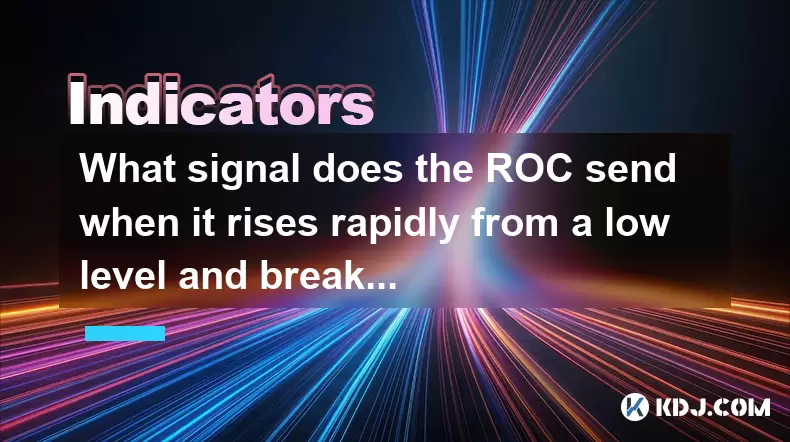
What signal does the ROC send when it rises rapidly from a low level and breaks through the zero axis?
Jul 27,2025 at 10:15am
Understanding the Rate of Change (ROC) IndicatorThe Rate of Change (ROC) is a momentum-based oscillator used in technical analysis to measure the perc...
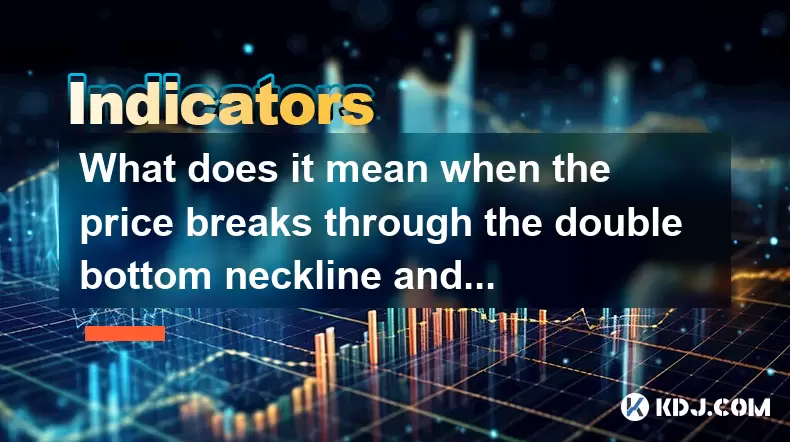
What does it mean when the price breaks through the double bottom neckline and the moving averages are arranged in a bullish pattern?
Jul 28,2025 at 10:57am
Understanding the Double Bottom PatternThe double bottom is a widely recognized reversal chart pattern in technical analysis, particularly within the ...
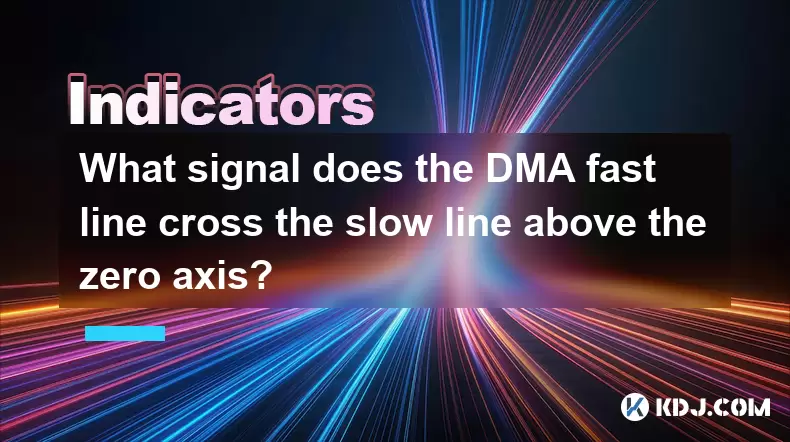
What signal does the DMA fast line cross the slow line above the zero axis?
Jul 28,2025 at 05:42am
Understanding the DMA Indicator and Its ComponentsThe DMA (Difference of Moving Averages) indicator is a technical analysis tool used in cryptocurrenc...
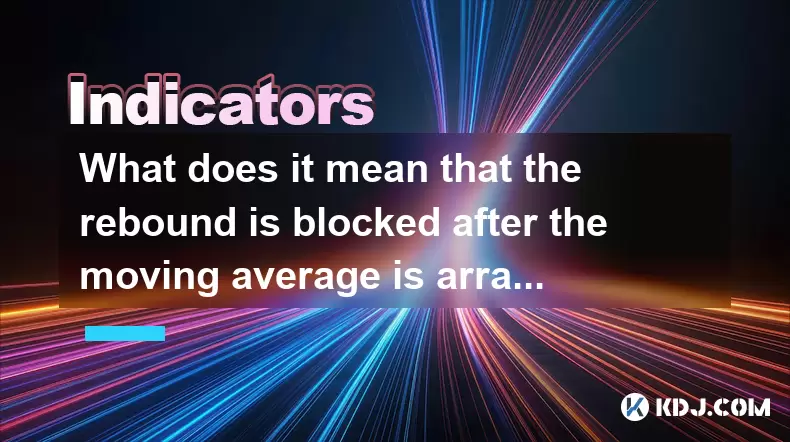
What does it mean that the rebound is blocked after the moving average is arranged in a short position for the first time?
Jul 26,2025 at 10:51am
Understanding the Short-Term Moving Average ConfigurationWhen traders refer to a 'short position arrangement' in moving averages, they are describing ...
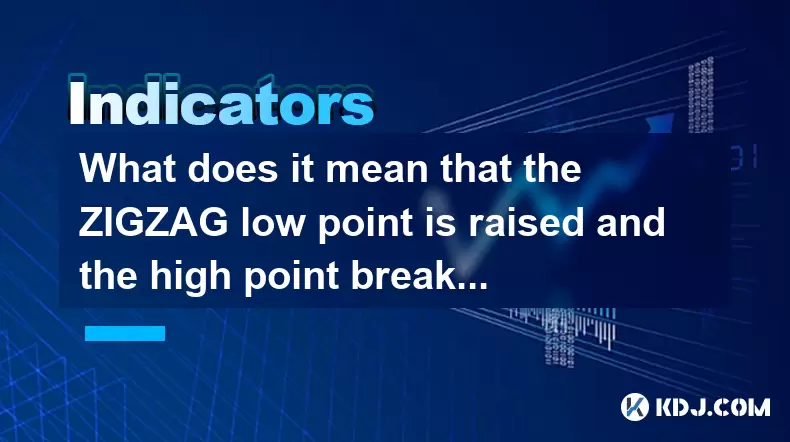
What does it mean that the ZIGZAG low point is raised and the high point breaks through the previous peak?
Jul 28,2025 at 03:28am
Understanding the ZIGZAG Indicator in Cryptocurrency TradingThe ZIGZAG indicator is a technical analysis tool widely used in cryptocurrency trading to...

What does it mean when the EMA combination crosses upward for the first time after sideways trading?
Jul 28,2025 at 03:43pm
Understanding the EMA and Its Role in Technical AnalysisThe Exponential Moving Average (EMA) is a widely used technical indicator in cryptocurrency tr...

What signal does the ROC send when it rises rapidly from a low level and breaks through the zero axis?
Jul 27,2025 at 10:15am
Understanding the Rate of Change (ROC) IndicatorThe Rate of Change (ROC) is a momentum-based oscillator used in technical analysis to measure the perc...

What does it mean when the price breaks through the double bottom neckline and the moving averages are arranged in a bullish pattern?
Jul 28,2025 at 10:57am
Understanding the Double Bottom PatternThe double bottom is a widely recognized reversal chart pattern in technical analysis, particularly within the ...

What signal does the DMA fast line cross the slow line above the zero axis?
Jul 28,2025 at 05:42am
Understanding the DMA Indicator and Its ComponentsThe DMA (Difference of Moving Averages) indicator is a technical analysis tool used in cryptocurrenc...

What does it mean that the rebound is blocked after the moving average is arranged in a short position for the first time?
Jul 26,2025 at 10:51am
Understanding the Short-Term Moving Average ConfigurationWhen traders refer to a 'short position arrangement' in moving averages, they are describing ...

What does it mean that the ZIGZAG low point is raised and the high point breaks through the previous peak?
Jul 28,2025 at 03:28am
Understanding the ZIGZAG Indicator in Cryptocurrency TradingThe ZIGZAG indicator is a technical analysis tool widely used in cryptocurrency trading to...
See all articles





















